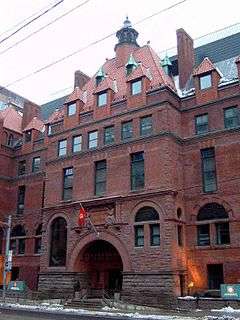Victoria Hospital for Sick Children
| Victoria Hospital for Sick Children | |
|---|---|
 The Victoria Hospital for Sick Children in 2005 | |
| General information | |
| Type | Institutional |
| Architectural style | Romanesque Revival |
| Location | College and Elizabeth streets, Toronto, Canada |
| Current tenants | Canadian Blood Services (Regional Centre) |
| Completed | May 1892 |
| Technical details | |
| Floor count | Four storeys |
| Design and construction | |
| Architect | Darling and Curry |
| Wikimedia Commons has media related to Victoria Hospital for Sick Children. |
Victoria Hospital for Sick Children is a building in Toronto, Ontario, Canada. The building served as a hospital until 1951 and currently serves as a blood centre. The building has received a Commendation of Adaptive Re-use from the Toronto Historical Board.
History
The hospital was built in 1892 by the architectural firm of Darling and Curry, and served as the hospital that is now called Hospital for Sick Children (or "Sick Kids") until 1951. The construction of the five-storey building was a very important step in the history of the hospital since it was previously located in a small downtown house which was rented for sixteen years by Elizabeth McMaster, the founder of the hospital, with support from a group of Toronto women (Toronto Archives). The invention of pablum, the introduction of incorporated x-rays in 1896, and the origins of the battle for compulsory milk pasteurization in 1908 occurred in this building (Adams 206). Since 1993, it has been home to Canadian Red Cross Regional Blood Centre and later the Canadian Blood Services Regional Blood Centre. It is located at the corner of College and Elizabeth streets, near the Toronto General Hospital.
Architecture
The building, which is made of sandstone, expresses the mood of the late 1880s when, under the influence of American architecture, Richardsonian Romanesque became a new trend in the design of buildings. In essence, as Kelly Crossman, the author of “Architecture in Transition: From Art to Practice, 1885-1906” claims, “during the last part of the nineteenth century, Canadian architecture was influenced by architectural trends in France, Great Britain, and the United States of America, and this impact was based on cultural and commercial connections”. In the 1880s, architects in the United States were experimenting with the construction of buildings using Romanesque style, as it had already begun to dominate American architecture. Since American and Canadian lifestyles were similar, and business connections were so tight, the new American architectural taste affected Canadian architects. The new trend influenced most Canadian architects, including Darling whose “favourite High Victorian Gothic design was no longer fashionable” (Crossman 9).
Expressing the mood of Canadian architecture of the late 1880s, the building has an impressive contrast against a background consisting of modern and postmodern architectural styles. The solidity of the exterior design of the building is due to the heavily rusticated stone that was used in the construction of massive, thick walls. It is further emphasized by stone masonry, a cavernous door opening, deep window reveals, and bands of windows. The roof of the Canadian Blood Services building has multiple steeply pitched roofs, an ordinary element of the Romanesque Revival architecture which provided the ventilation to the building (Adams 206).
The main entrance is one of the key elements of the building. In fact, having a cavernous door opening with steps and an entrance ramp for wheel-chair access in front of it, the entrance attracts even those who are not interested in architecture. Rusticated at the base, the arched entrance seems to be massive at the bottom; nonetheless, as it goes upper, the heavy stones are changed with smooth bricks, adding the impression of flow into the front facade. It acts as a transition to the visitor’s experience from the exterior to the interior of the building, when the Romanesque Revival building from the exterior turns out to have modern interior faces, accommodating advanced laboratories with the cutting-edge research, blood collection, testing and transplantation (Official SickKids).
Awards
The Canadian Blood Services building was awarded with Commendation of Adaptive Re-use by the Toronto Historical Board after it was reconstructed in 1993 by Parkin Architects (Official Parkin).
See also
References
- Adams, Annmarie. Medicine by Design: the Architect and the Modern Hospital, 1893-1943. Minneapolis: University of Minnesota, 2008. Print.
- Crossman, Kelly. Architecture in Transition: from Art to Practice, 1885-1906. Kingston [Ont.: McGill-Queens UP, 1987. Print.
- The Hospital for Sick Children (SickKids). "About Sick Kids." SickKids. The Hospital for Sick Children (SickKids). Web. 15 Oct. 2010. .
- Parkin Architects. "Canadian Blood Services Renovation." Parkin Architects Limited. Parkin Architects Limited. Web. 16 Oct. 2010. .
- Toronto Archives. "1892, Opening of the Hospital for Sick Children." Toronto. City of Toronto. Web. 15 Oct. 2010. .
- Canadian Red Cross Regional Blood Centre
- Lost Rivers - Hospitals for Sick Children
- SickKids History
- Victoria Hospital for Sick Children
Coordinates: 43°39′37″N 79°23′13″W / 43.660308°N 79.386912°W